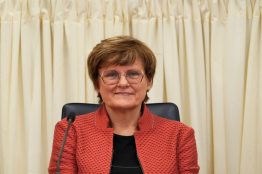"The Hungarian scientist who received the Nobel Prize" – Ferenc Krausz in service of humanity
"From the podium, it's hard to tell who will win a Nobel Prize, but you can see who is ambitious. Ferenc Krausz was one of my students who always tried to get the most out of the lectures and seminars," said Péter Richter, a university professor about his former student. Ferenc Krausz's Nobel Prize is a great achievement, however, it is an even greater one to do good in the world within one's means.

Two Hungarian Nobel Prizes in two days. It would be hard to argue with the claim that this was one of the most outstanding weeks in our country's scientific history. People walked around from Budapest to Szombathely to Békéscsaba as they did when the Hungarian football team beat one of the strongest teams on the continent: proudly, with their heads held high. Because at such times we feel that this is a joint success, the success of a nation whose most outstanding members are applauded by the world. And even though Ferenc Krausz lives in Germany and works as a professor at the University of Munich, he accepted the award as a Hungarian scientist: "My Nobel Prize is a Hungarian prize," he said.
Science for the physicist, magic for the layman
His work looks exactly as we imagine it. Electrical wires piled up to the top, seemingly in a tangled mess, metal boxes with functions we can't imagine, lasers, and all sorts of dazzling devices on metal tables and desks with holes in them, which we don't even need to name because for us it's pure magic. And that need not be understood by everyone; it is enough that only exceptional minds are allowed by God to enter the gate of secret knowledge, which we can only guess at the effect it will have on our lives.
For the scientist, it is possible to do what is inconceivable to anyone else: interpret time in billionths of a second, and even take a picture of this incomprehensibly short moment in time.
For those who may have last heard of atoms and electrons back in their school days, the research for which Ferenc Krausz was awarded the Nobel Prize with two other colleagues, Pierre Agostini, and Anne L'Huillier, is also of interest: “for experimental methods that generate attosecond pulses of light for the study of electron dynamics in matter”
Let's not be frightened by the word "attosecond", which is the unimaginably short moment of time in physics mentioned earlier. "Because electrons are more than a thousand times lighter than the atom and faster, you need a light pulse of extraordinary speed to capture their motion, but this cannot be produced in the visible light range, only much shorter wavelengths than light, so-called ultraviolet or extreme ultraviolet light," Ferenc Krausz explained to Élet és Tudomány (‘Life and Science’) magazine.
The experiment
"An excitation laser was fired into a container of noble gas, where the interaction caused the laser to excite the atoms in the gas, which emitted additional electromagnetic radiation (overharmonics). At certain intervals, these electromagnetic waves come into phase with each other and, in a very brief moment of time, are greatly amplified by the principle of interference, and then extinguish each other in the next very brief moment. A wave activity runs on the attosecond scale from large excursion to extinction. This is one billionth of a billionth of a second, or 10–18 seconds. There is a special branch of physics that deals with processes that take place in such a short time, called attosecond physics, which is a young branch of laser physics," explains physicist Péter Mati when asked.
If we imagine that we can continuously click with a camera and compile the resulting images as a film, the camera used by the physicist will take real-time pictures of the structural changes in atoms, i.e. the dynamics of the electrons in the atoms, at a much faster "shutter speed" than an ordinary camera. These images can also be assembled into a "film", capturing the changes that occur in a few attoseconds.
Help's on the way!
But you may wonder what we can do with the knowledge we have gained from Ferenc Krausz and his fellow scientists.
"Perhaps the most promising application of attophysics is in medicine. Illuminating cell samples with attosecond light can vibrate the electrons in their structure. In the cell, the molecules thus vibrated also emit radiation, which, after signal processing, can reveal certain differences between a healthy and a diseased cell, even in the initial stages of disease. Research along these lines is already underway under Krausz's leadership at the recently established Center for Molecular Fingerprinting," says Péter Mati.
One of the goals of the Centre is to make infrared molecular fingerprints a cornerstone of next-generation molecular diagnostics, opening up new ways to comprehensively assess the health of the population and detect diseases early. Today, we can only imagine how this discovery will change our quality of life, but in a few years' time, the technology of attosecond physics is likely to become part of our everyday lives.
And what is the mind of a real scientist like? Instead of leaning back in his armchair and resting on his laurels, he's already thinking of new challenges.
Future projects will focus on mapping the complex processes that take place in biological molecules. This could be best achieved by capturing the attosecond flashes of X-rays, which have wavelengths comparable to or shorter than the size of atoms and can therefore capture the movement of electrons at the atomic or molecular level. This would allow their motion to be reproduced in any complex system, which would be very important for detecting the progress of diseases, for example.
It is possible that Hungary could make a major contribution to the creation of the first electron video camera, which could also be used in healthcare. And there is something else: electrotechnology could be used not only to protect our health directly, but also indirectly: knowing and understanding how electrons move and what causes them to move could help to make computers process data at even higher speeds, or the internet faster. This would not only increase data traffic but would also make it possible to predict natural disasters faster.
One for all
Ferenc Krausz is so much of a non-individualist that as soon as he heard that he had been awarded the Nobel Prize, his first thought was how many colleagues' work had contributed to this achievement, he told the newspaper "Magyar Nemzet" ('Hungarian Nation'). Another important issue for the scientist is to stand up for issues that are important to all of us, such as education.
Within a newly established cooperation (SKOLA+ program), he provides financial support to primary and secondary school teachers who undertake to tutor children in need or from highly disadvantaged backgrounds, be they Ukrainian, Hungarian, or German.
On his visits home, Krausz saw the masses of people fleeing the war and was so moved that he and his colleagues at his research base set up a charity association specifically to support the victims of the war in Ukraine. A significant part of his current Nobel Prize prize money will also be distributed by the association he set up. This is not the first time that the Hungarian physicist has donated to charity: he has already donated a large part of the Wolf Prize he won and the whole of the Frontiers of Knowledge Prize.







